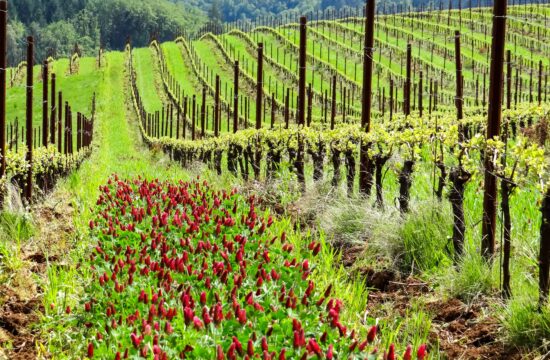Farmers and researchers are increasingly turning to cover crops as a powerful ally in the quest for sustainable and resilient agriculture.
These versatile plants, grown primarily to protect and enrich the soil during fallow periods, offer many benefits, including improving soil health and biodiversity, bolstering climate resilience, and enhancing farm profitability.
Here, we delve into the multifaceted benefits of cover crops and explore how they contribute to a more sustainable and productive agricultural system.
Cover crops have emerged as a vital component in the toolkit of sustainable farming practices. Read on to learn more about them.
What are Cover Crops?
Cover crops are plants that are grown to benefit the soil rather than for harvest. During fallow periods and between cash crops, cover crops are grown to improve soil health, reduce erosion, suppress weeds, and enhance nutrient cycling. Cover crops include a variety of plant species, such as legumes, grasses, brassicas, and cereals.
Common cover crops include clover, vetch, rye, oats, and radish. Leguminous cover crops are particularly valuable because they help fix atmospheric nitrogen and convert it into a form other plants can use. Meanwhile, grasses and cereals can reduce erosion and build soil organic matter, while brassicas are known to suppress weeds and mitigate soil-borne diseases.
Cover cropping is an important component of sustainable agriculture because it reduces the need for synthetic fertilizers and pesticides, improves soil fertility, and enhances the overall resilience of farming systems.
What are Common Types of Cover Crops?
There are various types of cover crops, each with its own unique set of benefits and uses. Five of the most common types of cover crops are:
- Legumes: Legumes are used as cover crops because they convert nitrogen from the air into a form that’s usable by other plants. A few examples of legumes are clover, vetch, and peas.
- Grasses: Grasses are known to control erosion, improve soil structure, and offer organic matter. Common grasses that are used as cover crops include annual ryegrass, winter wheat, and even oats.
- Brassicas: Brassicas belong to the mustard family and are useful cover crops as they help suppress weeds, reduce pest pressure, and control soil-borne diseases. Examples of brassica crops include turnips, radishes, and mustard.
- Cereals: Cereal crops such as wheat, rye, and barley are often used as cover crops because they produce large amounts of biomass, suppress weeds, and protect soil from erosion.
- Mixtures: Cover crop mixtures consist of several different plant species in a single crop. Mixtures provide many benefits including increased biodiversity, improved soil health, and enhanced pest control.
The specific type of cover crop you choose to plant will largely depend on the climate you’re in, soil type, and intended use of the land. We’d recommend you consult with your local agricultural expert to help you determine the best option for a particular farming system or goal.
What are the Benefits of Cover Crops?
The benefits of growing cover crops are most useful to farmers, the environment, and the agricultural system as a whole. Specific benefits of cover crops include but are not limited to:
1. Soil Health
Cover crops improve soil health, fertility, and biological activity by improving the structure of the soil, decomposing, increasing the amount of organic matter, and reducing erosion. Cover crops also benefit soil health by helping to suppress weeds and improve water infiltration and retention. Certain cover crops produce root exudates with natural herbicide effects and host beneficial microbes that ward off disease-causing organisms.
2. Improve Biodiversity
Cover crops help improve the biodiversity of agricultural systems by supporting the proliferation of beneficial bacteria, fungi, and other organisms, improving nutrient cycling and soil structure. They provide habitat and sources of nutrition for insects, pollinators, birds, and other wildlife. Cover crops also help to support more diverse and balanced ecosystems. The increased biodiversity from cover crops can enhance natural pest control, reduce the need for chemical inputs, and promote overall ecosystem resilience and stability.
3. Nutrient Management
Growing cover crops can reduce nutrient leaching, particularly of nitrogen, and increase nutrient availability for subsequent crops. They also help to fix nitrogen in the soil, reducing the need for synthetic fertilizers.
4. Pest Management
Some cover crops support pest management by attracting beneficial insects, fostering diverse microbial communities, and facilitating disease suppression. Natural pest control reduces dependence on chemical pesticides, maintains ecological balance, and enhances overall crop health and resilience.
5. Climate Resilience
These crops help contribute to climate resilience by sequestering carbon dioxide through photosynthesis, storing carbon in the soil, and reducing greenhouse gas emissions. Growing cover crops can help enhance the capacity of agricultural systems to adapt to changing environmental conditions.
6. Farm Profitability
Implementing cover crops can improve farm profitability by boosting crop yields through enhanced soil health, improved soil moisture conservation, suppressing weeds, reducing input costs by minimizing the need for synthetic fertilizers and pesticides, and ultimately improving the economic viability of agricultural operations. Improving soil conditions through cover crops can significantly reduce machinery costs, labor costs, and fertilizer costs.
7. Water Management
Cover crops improve water infiltration and holding capacity, protecting water quality by preventing nitrogen leaching into groundwater and surface water bodies. They also bind soil aggregates with their roots, reducing both wind and water erosion.
8. Weed Control
Cover crops can reduce weed growth by competing for resources and blocking sunlight. Specific cover crops can manage nematode populations and may produce natural compounds that suppress weeds. Brassicas release soil fumigants that can mitigate nematode pressure and suppress weeds and diseases.
What Cover Crops are Best to Use By Season?
The choice of cover crops to use by season depends on an array of factors, including the climate, soil type, crop rotation, and management goals. Here are some cover crop options by season:
Winter Cover Crops
In the winter, hardy cover crops like winter wheat, rye, and hairy vetch are grown to prevent erosion and scavenge nutrients. These crops also provide early spring forage for livestock.
Spring Cover Crops
Legumes such as clover and hairy vetch are grown in the spring to fix nitrogen and provide an early-season forage for livestock. Other cover crop options include oats and rye, which help suppress weeds and supply biomass.
Summer Cover Crops
Legumes that grow during the warmer months, like cowpeas and soybeans, are popular cover crop options in the summer because they can fix nitrogen and provide forage for livestock. Sorghum-sudangrass hybrids are also helpful for suppressing weeds and improving soil health.
Fall Cover Crops
Fall cover crops like cereal rye, wheat, and triticale are often planted during cooler seasons to protect the soil from erosion, scavenge nutrients, and improve soil structure. Brassicas such as turnips, radishes, and mustard can also control weeds and improve soil health in the fall.
Final Thoughts on the Benefits of Cover Crops
Cover crops offer various benefits for agriculture, including promoting soil health, enhancing biodiversity, bolstering climate resilience, and improving farm profitability.
Cover crops also play a role in mitigating climate change by sequestering carbon dioxide, reducing greenhouse gas emissions, and increasing farm resilience against unpredictable weather patterns.
Verdesian is committed to sustainable farming practices and provides valuable resources to optimize your agricultural endeavors. To maximize the benefits of cover crops, connect with one of our specialists who can offer personalized advice and guidance.
Embrace the benefits of cover crops and join the movement toward a resilient, profitable, and sustainable future in agriculture. Start reaping the rewards today.
Contact a SpecialistCover Crop FAQs
What are the disadvantages of cover crops?
Disadvantages of cover crops include additional costs for seeds and planting, the potential for increased labor, and the need for proper management to avoid issues like pest and disease carryover or competition with main crops.
Do cover crops add nitrogen to the soil?
Yes, certain cover crops, particularly legumes, can fix atmospheric nitrogen and add it to the soil, enhancing soil fertility and reducing the need for synthetic nitrogen fertilizers.
Are cover crops worth it?
Yes, cover crops are worth it for many farmers as they improve soil health, reduce erosion, enhance water retention, and can suppress weeds, leading to long-term agricultural benefits.
Do cover crops reduce the amount of fertilizer needed?
Yes, cover crops can reduce the amount of fertilizer needed by improving soil nutrient content and structure, particularly when using nitrogen-fixing legumes or deep-rooted species that bring up nutrients from deeper soil layers.


